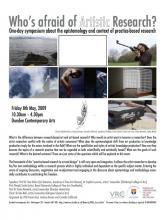English
Submitted by Armin Medosch on
Notes on Bauhaus: Community of Creative Workers
Submitted by Armin Medosch on
Thenextlayer at Getting Published Tuesday 28th April
Submitted by Armin Medosch on
Handrail at 28 Metres
Submitted by Lindsay on
Handshakes amongst strangers: P2P and the production of disorder within informational capitalism
Submitted by doll_yoko on
Art and Research
Submitted by Lindsay on
Who is Afraid of Artistic Research? (3)
Submitted by Lindsay on

